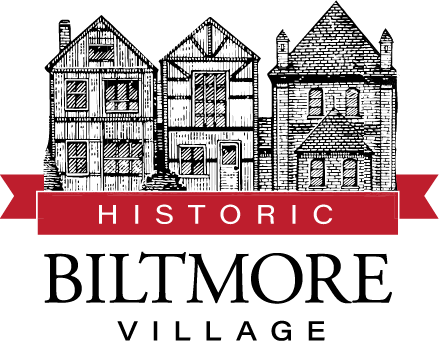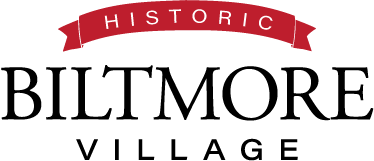
History
Nestled in the mountains, near the point where the Swannanoa River flows into the French Broad, there is a beautiful land. Natural resources are abundant. The bottomland is rich and fertile. And the history is long and varied. Before it was Biltmore Village, it was the town of Best. Before that, it was home to the Cherokee. If you’ve ever visited, if you’ve ever seen the area, it’s easy to understand why so many people from so many eras have been eager to call this place home.
Biltmore Village was originally modeled after and still, today resembles a small English village. It boasted the area’s first railroad station but was transformed into an idyllic village that served not only to provide a fitting entrance to George Vanderbilt’s Biltmore Estate but also to function as an independent and self-sustaining community. From the beginning, it was described as a “model village” and as “A Millionaire’s Village,” among epithets. Biltmore Village was and is a uniquely designed place—unique because it was originally built and owned by a single individual, but also because it was designed and built as one of the earliest examples of a planned mixed-use community where people would live and work and have all the necessary amenities, including stores, post office, school, and church, close at hand.
Timeline
George Vanderbilt Arrives in Asheville
Vanderbilt purchased land comprising the majority of the beautiful and appropriately named town of Best. On this land, he would build Biltmore Village.
Construction of Biltmore Estate Begins
Frederick Law Olmsted, co-designer of New York’s Central Park, and celebrated architect, Richard Morris, collaborate on what will become the iconic Biltmore Estate, home of George Vanderbilt.
Construction Begins on All-Souls Church
The parish church for Biltmore Village set the tone, both spiritually and architecturally. All Souls was consecrated as an Episcopal church in 1896. Construction was finally completed in 1905.
Streetcar Line Built From Courthouse To Biltmore
One of the first electric street railways in the country, The Asheville and Biltmore Electric Street Railway served many of the skilled workers who built the Biltmore Estate.
Biltmore Parish Day School Opens
Established so that the worker’s children could get an education, the school employed 2 teachers and taught 29 children when it opened. Vanderbilt’s daughter, Cornelia, attended the school.
Cottages On All Soul’s Crescent Completed
Built to provide homes for the workers at the Biltmore Estate, the cottages were designed by Richard Sharp Smith, who had worked closely with Richard Morris Hunt before Hunt’s death in 1895.
Biltmore Post Office Built
Representing another step toward making Biltmore Village a completely self-sufficient community, the post office was erected on Brook Street, adjacent to the railroad station.
The Kenilworth Inn Burns Down
As most guests slept, a fire broke out at the north end of the hotel. A porter was severely injured in a fall from the third floor, but all guests escaped serious injury. The hotel itself was a total loss.
Plaza Business Center Completed
This was essentially the main street of Biltmore Village. Residents could find everything they needed in the shops of the business center, which included a general merchandise store, a grocery, a meat and produce market, hardware store, a café, and a drug store.
George Vanderbilt Dies
The force behind the construction of Biltmore Estate and Biltmore Village died from complications after an appendectomy. His wife, Edith, inherited his estate.
Flood Ravages Biltmore Village
Two different hurricanes, one from the Gulf and one from the Atlantic, hit Asheville in rapid succession, causing the French Broad and Swannanoa Rivers to flood low-lying areas including Biltmore Village. Flood damage was extensive. A total of twenty-nine souls were lost in the disaster.
New Kenilworth Inn Completed
The new Kenilworth Inn was built in the Tudor Revival style on the foundation of the original inn by furniture maker turned real estate developer, James Madison Chiles. One month after construction was complete, the US Army took control of the building, converting it into a hospital. In 1923, it finally began operating as the luxury hotel it was originally built to be.
Edith Vanderbilt sells Biltmore Village
In the aftermath of the 1916 flood, upkeep of her extensive property holdings proved difficult for Mrs. Vanderbilt. As a result, she sold most of Biltmore Village (except All Souls Church, it’s associated buildings, the hospital, and the train depot) to George Stephens of the Appalachian Property Company.
Biltmore Forest Built
The housing development was constructed on a tract of land sold by Edith Vanderbilt. Many of the area’s grandest homes would be built there on and around the newly constructed Vanderbilt Road.
Biltmore-Oteen Bank Built
Built to serve the thriving community, the bank would not survive the Great Depression. The Georgian Revival style building, however, still stands in Biltmore Village.
New Drug Store Opens
Indicative of the rapid growth Biltmore Village experienced in the twenties, the new drug store was built to serve a growing population and featured delivery, a prescription service, and a soda fountain.
Flood Strikes Again
In a replay of 1916, both the French Broad and Swannanoa rivers spilled over their banks, once again leaving parts of the Biltmore Village underwater.
First Annual Village Art & Craft Fair
Founded as a celebration of the crafts, which had played such an integral role in Biltmore Village’s history, the fair quickly developed a reputation as one of the finest in the region.
First Annual Dickens Festival
A celebration befitting the English manorial-style Biltmore Village, the festival sought to recreate a Victorian Christmas straight out of Dickens’ famous tale and featured caroling, performances, and holiday festivities.
World’s Fanciest McDonald’s Opens
An interesting example of Biltmore Village’s building guidelines at work, the McDonald’s, which features a grand piano and a stone fireplace, was made to blend in with the timeless architecture of the village.
The President Visits
While visiting Asheville with family and friends, President Barack Obama visits Biltmore Village, eating dinner at Corner Kitchen, a restaurant currently occupying one of the historic cottages on Boston Way.
Additional History Notes
Biltmore Village has been home to many community activities throughout the years.
In 1898, the village greens were used for military drill exercise during the Spanish-American War.
In September 1902, when U.S. president Theodore Roosevelt visited the estate, schoolchildren assembled on the village green in a tiled pavilion decorated with bunting and flags.
The Parish School utilized the village greens on either side of Lodge Street as a baseball field and for activities such as May Day celebrations, which included the erection of a Maypole and decorated throne for the May Queen.
In August of 1903, the 1st Regiment of the National Guard (about 600 men) made a summer encampment in the Village for five days.
Edith Vanderbilt planned and held many events in Biltmore Village. On May 8, 1905, the New York Times printed an article titled “Floral Parade at Biltmore” that claimed, “Mrs. George Vanderbilt Plans for Show to Rival California’s.” Her Biltmore Village parades featured carriages creatively decorated with flowers and greenery. Residents of the estate, the village, and surrounding areas participated in these special occasions.
Biltmore Village housed the Boys Club as early as 1903, and ultimately became the Boys and Girls Club. The club’s mission was expanded to one of education and included classes in woodcarving, cabinetmaking, basketry, and weaving to teach marketable skills to the students. In 1905, the older and more advanced students were reorganized as Biltmore Estate Industries, supported financially by Edith Vanderbilt and located at 8 Plaza.
In 1918, Dwelling No. 16 on All Souls Crescent was leased as officers’ quarters; and as of February 1920, a cottage and three stores in Biltmore Village were still being leased by the U.S. government.
On April 29, 1924, Cornelia Vanderbilt married the Honorable John Francis Amherst Cecil in Biltmore Village at All Souls Church. In the days before the wedding, the village bustled with activity as family members, friends, and guests from around the world arrived. The union was perhaps the most significant social event that occurred in Biltmore Village during the 1920s. As the newlywed couple left the church, they were greeted by children of Biltmore Estate workers forming an aisle with branches of flowers held high.
Biltmore Village has weathered many floods, several quite devastating, throughout the years, but interestingly enough, the Cathedral of All Souls has not flooded once.
-Excerpts and adaptations from Around Biltmore Village by Bill Alexander






















